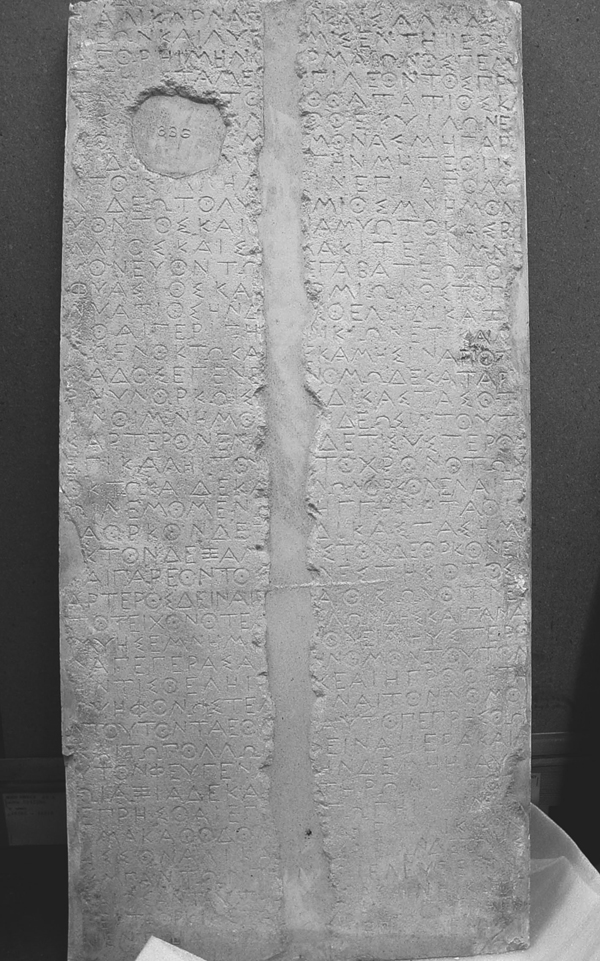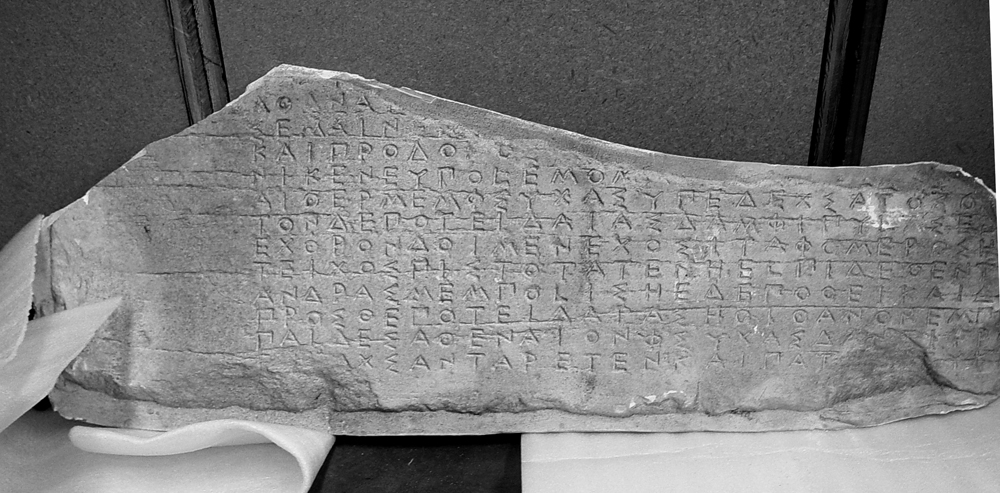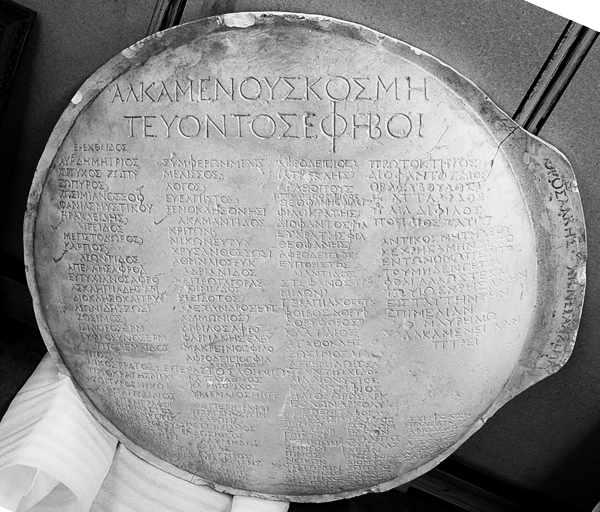

Among the large collection of plaster casts owned by the Phoebe Apperson Hearst Museum and the Department of Classics (unfortunately not currently available for public viewing or use by students) are several casts made from Greek inscriptions, three of which are illustrated here.

This cast is from a marble stele in the British Museum. The text is presented and discussed by Russell Meiggs and David Lewis in A Selection of Greek Historical Inscriptions to the End of the Fifth Century B.C. (Oxford 1969), no. 32. The text was first transcribed in Halikarnassos (Budrum, Turkey) in 1749, and the stone was subsequently sawed in half so that the blocks could be used in a building: hence the blank area in the middle where several letters are now missing from each line.
The decree (estimated date 465-450 BCE) sets forth some rules for dealing with disputed property. It is carved in Ionic letters. There are dots in the omicrons and omegas, and a special character, archaic sampi (like a capital T with very short descenders at each end of the horizontal bar; the horizontal of the tau is without these adornments) represents what is usually shown later as a double sigma. Here is a transcription of lines 2-6. This image does not show all of line 1. The sampi (once in line 2 and twice in line 6) may not appear on your screen unless you have a font with Unicode version 5.1 Greek.
2 Ο]ΑΛΙΚΑΡΝΑͲ[ΕΩ]ΝΚΑΙΣΑΛΜΑ[ΚΙ
3 Τ]ΕΩΝΚΑΙΛΥΓ[ΔΑ]ΜΙΣENTHIIERH[I
4 Α]ΓΟΡΗΙΜΗΝΟ[ΣΕ]ΡΜΑΙΩΝΟΣΠΕΜ
5 ΠΤΗ[ΙΙ]ΣΤΑΜΕ[ΝΟΕ]ΠΙΛΕΟΝΤΟΣΠΡΥ
6 ΤΑΝ[ΕΥΟΝ]ΤΟ[ΣΤ]ΟΟΑͲΑͲΙΟΣΚΑ
The next piece shown here is a cast from a broken remnant of a verse inscription (actually three successive four-line poems in elegiac couplets) memorializing the Athenians who died at Poteidaia in the campaign (432-430 BCE) that preceded the Peloponnesian War, as described by Thucydides in Book 1.56-65 and 2.70 of his Histories. This inscription is in the old Attic alphabet, with Η used for the aspirate rather the vowel eta, with Ε appearing for eta and spurious epsilon-iota as well as epsilon, with Ο appearing for omega and spurious omicron upsilon as well as for omicron, and with ΦΣ used in place of psi and ΧΣ in place of xi. At several points a final nu is assimilated to mu before the initial pi of the next word. It is published in Inscriptiones Graecae I (3rd ed.), no. 1179 and in P. A. Hansen, Carmina Epigraphica Graeca I (Berlin 1983) no. 10.

Here is a transcription of the letters that can be read on this image:
ΑΘΑΝΑΤ[
ΣΕΜΑΙΝΕΙ[
ΚΑΙΠΡΟΔΟ[
ΝΙΚΕΝΕΥΠΟΛΕΜΟΜ[
ΑΙΘΕΡΜΕΜΦΣΘΧΑΣΥΠΕΔΕΧΣΑΤΟΣΟ[
ΤΟΝΔΕΠΟΤΕΙΔΑΙΑΣΔΑΜΦΙΠΥΛΑΣΕ[
ΕΧΘΡΟΝΔΟΙΜΕΝΕΧΟΣΙΤΑΦΟΜΕΡΟΣΗ[
ΤΕΙΧΟΣΠΙΣΤΟΤΑΤΕΝΗΕΛΠΙΔΕΘΕΝΤ[
ΑΝΔΡΑΣΜΕΜΠΟΛΙΣΗΕΔΕΠΟΘΕΙΚΑΙΔ[
ΠΡΟΣΘΕΠΟΤΕΙΔΑΙΑΣΗΟΙΘΑΝΟΝΕΜΠ[
ΠΑΙΔΕΣΑΘΕΝΑΙΟΝΦΣΘΧΑΣΔΑ[
Η[..]ΑΧΣΑΝΤΑΡΕΤΕΝΚΑΙΠΑΤ[....]ΥΚ[
Thanks to a much older drawing of the stone at a time when more was extant and to some probable restorations, a somewhat more complete text in modern script can be provided:
Ἀθάνατόν με θα[νο
σημαίνειν ἀρετ[ὴν
καὶ προγόν...[ (editors give this, but the cast clearly shown προδο[)
νίκην εὐπόλεμον μνῆμ’ ἔλαβον φθ[ίμενοι.
Αἰθὴρ μὲν ψυχὰς ὑπεδέξατο, σώ[ματα δὲ χθὼν
τῶνδε· Ποτειδαίας δ’ ἀμφὶ πύλας ἔλ[υθεν.
ἐχθρῶν δ’ οἱ μὲν ἔχουσι τάφου μέρος, ο[ἱ δὲ φυγόντες
τεῖχος πιστοτάτην ἐλπίδ’ ἔθεντο [βίου.
Ἄνδρας μὲν πόλις ἥδε ποθεῖ καὶ δ[ῆμος Ἐρεχθέος,
πρόσθε Ποτειδαίας οἳ θάνον ἐν πρ[ο]μάχοις
παῖδες Ἀθηναίων· ψυχὰς δ’ ἀντίρρο[π]α θέντες,
ἠ[λλ]άξαντ’ ἀρετὴν καὶ πατρ[ίδ’] εὐκλ[έ]ϊσαν.
From an even later period of Attic epigraphy (ca. 200 CE) comes the ephebic shield inscription, a dedication listing ephebes (young men reaching the age of maturity going through preliminary military training before taking up the full role of adult males). This text appears in Inscriptiones Graecae II/III (2nd ed.) as no. 2191. The large letters at the top give the title, "Ephebes when Alkamenes was superviser" (ΑΛΚΑΜΕΝΟΥΣ ΚΟΣΜΗΤΕΥΟΝΤΟΣ ΕΦΗΒΟΙ), while the rest of the shield lists the ephebes by tribe, with a tribal name in the genitive followed by a list of several names in the nominative. Some signs of the period of this inscription are provided by the presence of a tribe named after the emperor Hadrian, the use of ligatures (as the eta/beta near the end of the second line of the title, and abbreviated names (there are oblique strokes above the last carved letter of an abbreviated name, as above the rho in line 2: ΑΥΡ for ΑΥΡΗΛΙΟΣ). A few names are followed by an antisigma (Ͻ), which indicates that the ephebe has the same name as his father.

Click here for a larger image of the shield.
Here is a transcription of the first 15 lines of the left column of names:
ΕΡΕΧΘΕΙΔΟΣ
ΑΥΡΔΗΜΗΤΡΙΟΣ
ΙΣΙΤΥΧΟΣ ΖΩΠΥ
ΖΩΠΘΡΟΣϽ
ΖΩΣΙΜΙΑΝΟΣΣΟΦ
ΦΑΝΙΑΣΜΥΣΤΙΚΟΥ
ΗΡΑΚΛΕΙΔΗΣϽ.
ΑΙΓΕΙΔΟΣ
ΜΕΓΙΣΤΟΔΩΡΟΣϽ
ΚΑΡΠΟΣϽ
ΛΕΟΝΤΙΔΟΣ
ΑΠΕΛΛΗΣΑΦΡΟΔ
ΕΥΤΥΧΙΑΝΟΣΑΦΡΟΔ
ΑΣΚΛΗΠΙΑΔΗΣΑΠΟ
ΔΙΟΚΛΗΣΟΚΑΙΤΡΥΦ